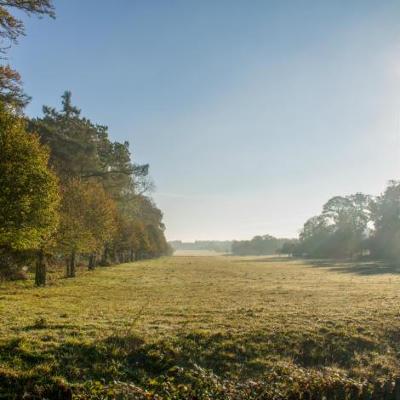Three Great Estates Walking Tour

Experience the history and beauty of three of Norfolk's greatest houses and their estates.
With wonderful walking options on the Peddars Way and Norfolk Coast Path National Trail, this itinerary contrasts of luxury with adventure, cultivated landscape with wilder ones.
- Number of days: Three
- Difficulty: Gentle
- Distance: 14.97km/9.3 miles total walking plus a day at Sandringham Estate
- Landscape: Historic houses and great estates, parkland and dramatic coastlines
- Start/end: Houghton/Sandringham/Holkham
- Best time of year: spring to autumn (based on opening times)
Day 1
- Distance: 7.37km/4.58 miles
Start your tour at Houghton Hall with our Houghton circular route. Follow charming green lanes and the historic Peddars Way, with views across open fields containing Bronze Age burial sites.
At Houghton Hall, the Stables Café offers hot and cold food using produce grown locally and on the estate. Spend the afternoon wandering in the gardens, admiring the sculpture collection, or visit the Soldier Museum, the world's largest collection of model soldiers. The Museum was started by the 6th Marquess of Cholmondeley as a school boy. He continued to commission scenes throughout his life, including impressive reconstructions of the battles of Waterloo and Omdurman. With other exhibits by resident and internationally renowned artists you'll easily fill an afternoon here.
Houghton Hall was built between 1722 and 1735 by Sir Robert Walpole (1674-1745), the first British Prime Minister. The creamy gold façade of the building is attributed to sandstone quarried in Yorkshire which was shipped to King's Lynn. The building is in the style of English Palladianism, and is home to a magnificent collection of art and surviving furniture. Following the death of Horace Walpole, 4th Earl of Orford, the estate passed down the female line to the Cholmondeley family in 1797. Although the history of the present Hall begins with Sir Robert Walpole, Houghton has been the home of the Walpole family since the 12th century.
The medieval church within the park is dedicated to St Martin of Tours. Together with a nearby medieval cross, this would have been the focus of the medieval village of Houghton. The medieval village was moved just outside the park gates in 1729 to accommodate the new Hall and expansion of the park. Two rows of identical whitewashed brick cottages built on both sides of the road became the new village of Houghton.
For Houghton Hall opening times and visitor information, visit the Houghton Hall website (opens new window).
Day 2
Sandringham House is best known as the country retreat where the royal family spends Christmas. But its fascinating history and impressive architecture make it worth a visit.
The estate was bought by the future King Edward VII from Charles Cowper in 1862. The house was then largely rebuilt in a Jacobean style between 1867 and 1870. Red brick and stone dressings make up the exterior. Many gables and cupolas contribute to the elegant beauty of the building. The surrounding Sandringham Park is a wonderful place to relax in and explore. The church of St Mary Magdalen in Sandringham dates back to the 14th and 15th centuries and its grand interiors are unrivalled in all of Norfolk. The abundant decorations combined with the exterior frame of ancient and restored stone make this church one of the treasures of Sandringham. It also marks the rich medieval history of the parish and nearby villages of West Newton and Babingley.
Sandringham Estate website recommends you allow at least four hours to make the most of what's on offer. With a café and restaurant, country clothing shop and gift shop at Sandringham Visitor Centre, you could probably stay for longer.
There is free parking.
For more information and opening times, visit the Sandringham Estate website (opens new window).
Day 3
- Distance: 7.6km/4.72 miles
Walk or take the Coastal Hopper bus from Wells to Holkham Hall, the ancestral home of the Earls of Leicester. The hall and garden are spectacular, like a fantasy palace set in a picture-perfect parkland landscape. After spending the morning at Holkham Hall, walk eastwards towards Wells-next-the-Sea. Enjoy this wonderful stretch of coast running through pinewoods or stroll along the award winning golden beach.
Holkham Hall was built in the Palladian style, its interiors adorned with Classical decoration. The beautiful landscape garden includes a pond and a 19th century orangery, as well as stables and a coach block and estate offices. The medieval village of Holkham was moved from the park in the 18th century. The villagers were rehoused in new estate cottages. Roads, trackways, and modest dwellings clustered around a small common made up the landscape of medieval Holkham. The surrounding areas also reveal clues about Iron Age and Saxon occupation.
Holkham Estate has a choice of cafés and the Victoria Inn for food and drink.
For visitor information and opening times, visit the Holkham website (opens new window).
For Coastal Hopper bus timetables go to the Sanders Coaches website (opens new window).
Accommodation
For a map of bookable accommodation options as well as a tool to create your own itineraries see the National Trails website (opens new window).
Rest days
If you're planning to stay for a while longer, and want to learn more about the heritage of north-west Norfolk, pay a visit to Lynn Museum, in King's Lynn.
